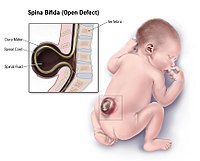
Photo from wikipedia
PURPOSE Many children with spinal muscular atrophy (SMA) develop progressive spinal deformity, worsening already compromised pulmonary function and global spinal balance. Early results demonstrate that intrathecal administration of nusinersen, a… Click to show full abstract
PURPOSE Many children with spinal muscular atrophy (SMA) develop progressive spinal deformity, worsening already compromised pulmonary function and global spinal balance. Early results demonstrate that intrathecal administration of nusinersen, a recent FDA-approved drug, improves motor function and ventilator-free survival, necessitating preservation of intrathecal access when considering PSIF. The purpose of this study is to assess medium-term outcomes of a specialized approach for posterior spinal instrumentation and fusion (PSIF) to preserve intrathecal access in patients with SMA. METHODS A retrospective review of patients with SMA undergoing PSIF at a single tertiary academic medical center during a 3-year period was completed. To facilitate intrathecal drug administration, the traditional approach to PSIF was modified to "skip" one or more intervertebral levels at the thoracolumbar junction. Clinical notes and radiographs were reviewed for postoperative outcomes including major coronal curve correction and complications, including loss of correction, hardware failure and surgical revision. RESULTS Eight patients were identified, with a mean age of 12.7 ± 1.6 years and follow-up of 4 years. These patients had a mean preoperative major coronal curve of 56.4°, with mean curve correction of 35.2°. At follow-up, no patients experienced rod breakage, loss of correction, or postoperative chronic pain. Only one patient required revision surgery due to bony overgrowth at the skipped level after three and a half years. CONCLUSION Implementing the skip construct approach for PSIF in patients with SMA allows for scoliosis correction without compromising intrathecal drug delivery. Follow-up at 4 years reveals no adverse clinical events, hardware failure or loss of correction. LEVEL OF EVIDENCE IV.
Journal Title: Spine deformity
Year Published: 2020
Link to full text (if available)
Share on Social Media: Sign Up to like & get
recommendations!